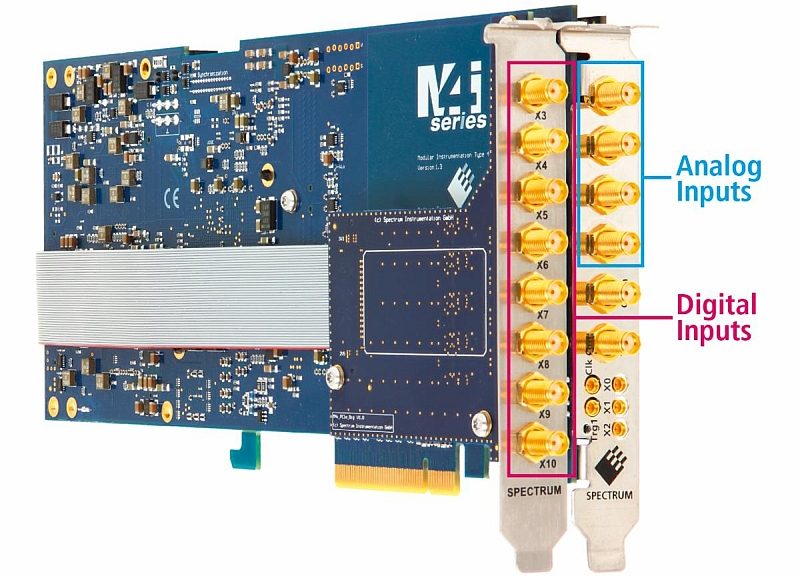- Spectrum Instrumentation offers the M4i.44xx-DigSMA option with 8 additional digital inputs on all its “44” series PCIe digitizers with two or four analog inputs.
- This option takes the form of a module, with 8 digital input lines, which is installed next to the acquisition card.
- This digital input module shares the clock and trigger system with the acquisition board with which it is associated, thus ensuring the synchronization of the digital and analog inputs.
The Spectrum M4i.44xx series of PCIe digitizer cards consists of eight different models. Users can select from versions that have either two or four analog channels and sampling rates of 180 or 250 MS/s, with 16-bit resolution, or higher speeds of 400 or 500 MS/s, with 14-bit resolution. The digitizer cards of the “44” series are equipped with analog signal conditioning (6 input ranges, selectable input impedance, offset, etc.) and triggering capabilities. The acquired data can be stored in a 2 GSamples of on-board memory or transferred to a PC in a variety of memory read-out modes, including FIFO streaming, at rates up to 3.4 GB/s.
The cards have additional front panel connections that include two external trigger inputs, an external clock reference input, clock output and three general purpose I/O lines that are available for asynchronous I/O operations.
The new M4i.44xx-DigSMA digital input option has a separate PCIe faceplate, occupying an additional PCIe slot, with 8x SMA type connector. Each input has an impedance of 10 kOhms (to 3.3 V). This allows the inputs to handle 3.3 V LVTTL signals with input voltage levels between -0.5 V and +4.0 V. The digital input bandwidth is 125 MHz and software selection enables both synchronous and asynchronous acquisition modes.
When using the digital input option, the digital data is stored inside the analog samples by reducing a channel’s resolution. This allows phase synchronization of both the analog and digital signals, as the one-bit digital signals are placed in the high order bits of the analog waveforms. As an example, if eight digital channels are in use, then the resolution of the analog channels would be reduced from 16 to 14 bits and two of the digital signals would be appended to each analog channel of a four-channel digitizer.
For applications that require more channels, Spectrum enables multiple M4i.44xx series cards to be connected together with its Star-Hub system. Star-Hub permits a maximum of eight cards to all share a common clock and trigger. For instance, by connecting together three M4i.4451-x8 digitizers, two with the M4i.44xx-DigSMA digital option and one with the star-hub option, a single system can be made that has 12 analog and 16 digital channels.
The digitizers, and the digital input option, are supported by the Spectrum software development kit (SDK) which includes programming using C++, C#, VB.NET, Python, JAVA, LabVIEW or MATLAB. The SDK is included as standard with every unit along with a base version of Spectrum’s own software, SBench 6. This program lets users control all the modes and settings of the hardware via a user interface.






